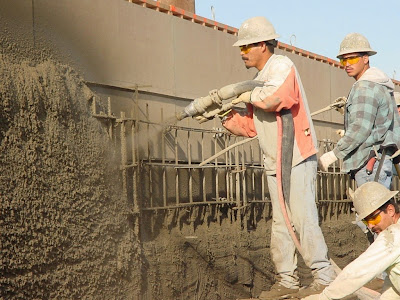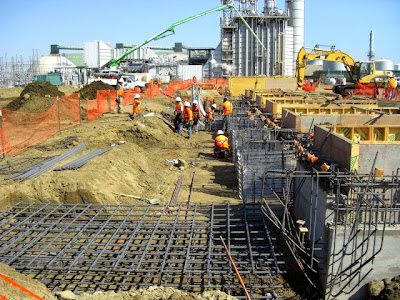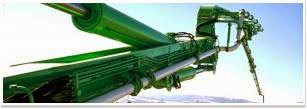The purpose of chemical admixtures is
to give concrete additional properties in order to better handle a range of variables
such as pumping requirements or placing concrete in extreme weather
conditions. According to the National
Ready Mix Concrete Association (NRMCA), admixtures are added to concrete to
increase “durability workability or strength characteristics of a given
concrete mixture.”
The Portland Cement Association further
adds that, “Admixtures are classed according to function. There are five
distinct classes of chemical admixtures: air-entraining, water-reducing,
retarding, accelerating, and plasticizers (superplasticizers).”
Air-entraining is the process of intentionally
inserting microscopic air bubbles into the concrete. It is done to improve the concrete’s
workability as well as to increase its durability in extreme freezing and
thawing temperature cycles. The only
downside to air-entraining is that the concrete experiences a 5% reduction in
strength for each 1% of air added; however, the segregation and bleeding is
diminished or completely eliminated.
Accelerators are another type of
chemical admixtures and are used to increase the early strength of concrete by
causing it to harden faster. They are
also used to protect concrete from extremely cold weather or if a project has a
tight deadline. Chemical accelerators can
be either chloride based or non-chloride based and one common inexpensive
example is calcium chloride.
For situations where you need to slow
down or delay the hardening process such as requiring a slower pour due to the
scope of the project or in very hot temperatures, a retardant may be used. This gives crews more time to effectively
place and finish the concrete. Sugars,
lignin, and citric and tartaric acids are all common retardants.
Chemical admixtures can be in a liquid
or powder form and are added to the concrete mix along with portland cement,
aggregate and water and typically make up less than 5% of the total concrete mix. Regardless of
whether chemical admixtures are derived from natural or manufactured chemicals,
they are added to the concrete either immediately before or during the mixing
process.
At The Conco Companies, our mission is
to be the best supplier of concrete services in the Western United States and
to bring our expertise, experience and quality to each project. We continue to upgrade and expand facilities
to better serve the growing market for public works projects, commercial,
parking structures, educational, and other construction development. We have
offices in California, Washington State, Oregon, Colorado and Nevada.
Sources:cement.org/cement-concrete-basics/concrete-materials/admixtures,
nrmca.org/aboutconcrete/cips/15p.pdf







